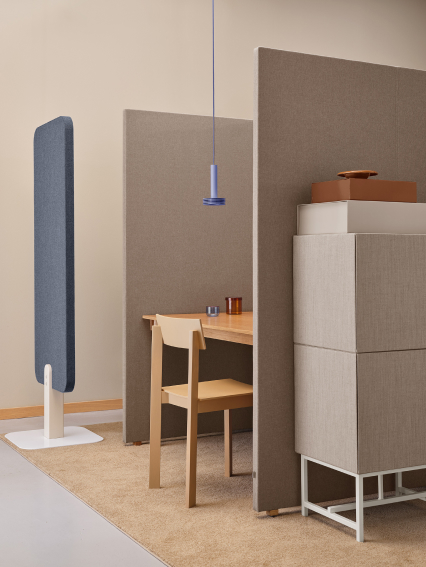Research conducted by Leesman reveals that 67% of employees express dissatisfaction with the sound environment in their workplace. The sound environment plays a pivotal role in whether employees want to be in the office. By selecting the appropriate solution, you can increase both well-being and productivity.

In this case study, we will lead you through diverse scenarios and their impact on the sound environment. Our study rests upon the Speech Transmission Index (STI), a metric determining the clarity of speech intelligibility. It is measured on a scale between 0.0 and 1.0, where at 1.0 you hear the speech sound crystal clear. Less distinct speech makes it easier for you to concentrate.
For simplicity’s sake, our measures have been categorized into three colors:
- Red (STI > 0.5) – speech is perceived clearly.
- Yellow (STI 0.2-0.5) – speech is partially perceived.
- Green (STI < 0.2) – speech can only be perceived as muffled.
Scenarios and distinctions
The scenarios included in this case study range from scenario 0, where no screens are used, to scenario 4, which significantly reduces acoustic and visual noise.
Scenario 0 – No screens
In the initial phase, there were no screens used. As you can see in the graphics, speech can be perceived clearly throughout the space. While conducive for specific contexts like conference rooms, this setup proves challenging for workstation spaces, as it will be difficult for employees to focus and perform their tasks.

Scenario 1 – PET table screens
Transitioning to scenario 1, we introduce table screens made of recycled PET material. These screens, 30 millimeters (1.2”) in thickness, ascend to a height of 520 millimeters (20.5”) above the table. The graphics showcase a marginal reduction in noise over longer distances. However, a substantial area still retains distinct speech perception.

Scenario 2 – Stone wool table screens
In the second scenario, we introduce Dezibel Table screens, made of high-density stone wool. Measuring 40 millimeters (1.6“) in thickness and rising 600 millimeters (23.6”) above the table, these screens reduce visual noise and distractions. Noteworthy is the visible expansion of the area devoid of speech perception, making it much easier for employees to concentrate on their tasks.

Scenario 3 – Stone wool table screen cubicles
Scenario 3 builds upon the previous scenario by incorporating side screens to create individual table cubicles. Utilizing high-density stone wool, these 40 millimeters (1.6“) thick screens rise 600 millimeters (23.6”) above the table. This setup not only enhances the sound environment at varying distances. It also reduces visual fatigue by diminishing distractions.

Scenario 4 – Stone wool floor screen cubicles
The final scenario embodies a significant improvement. Speech perception becomes notably elusive, and visual disturbances are entirely eradicated. Employees can fully concentrate on their tasks without being disturbed by sound or visual noise.
These Classic floor screen cubicles, with a thickness of 68 millimeters (2.7”) of high-density stone wool, ascend to a height of 1 900 millimeters (74.8”).

Summary
The most expensive choice you can make is to do nothing at all. It can give rise to stressed and dissatisfied employees, coupled with diminished productivity. The second most expensive choice is selecting something that won’t solve your problems.
Your choice exerts considerable influence, yet the process can be intricate. We recommend:
- Conducting a meticulous analysis of your space and needs, a task we are keen to assist with.
- Accounting for both acoustic and visual disturbances.
- Selecting the right quality products, the right amounts, and the right placements.
Leveraging floor screen cubicles crafted from high-density stone wool emerges as an efficient means of nurturing a calm workspace, nurturing employee well-being and amplifying productivity. Nonetheless, it’s worth noting that situations will arise when collaborating with colleagues and staying connected to the surroundings are desired. The solution lies in embracing variation, establishing various zones – zones with floor screen cubicles for focused endeavors and areas for collaborating featuring for example table screens or no screens at all.
Do you want assistance in evaluating your space and identifying a tailored solution? With nearly two decades of experience, we have been instrumental in enhancing sound environments for numerous companies. Get in touch with us today.


